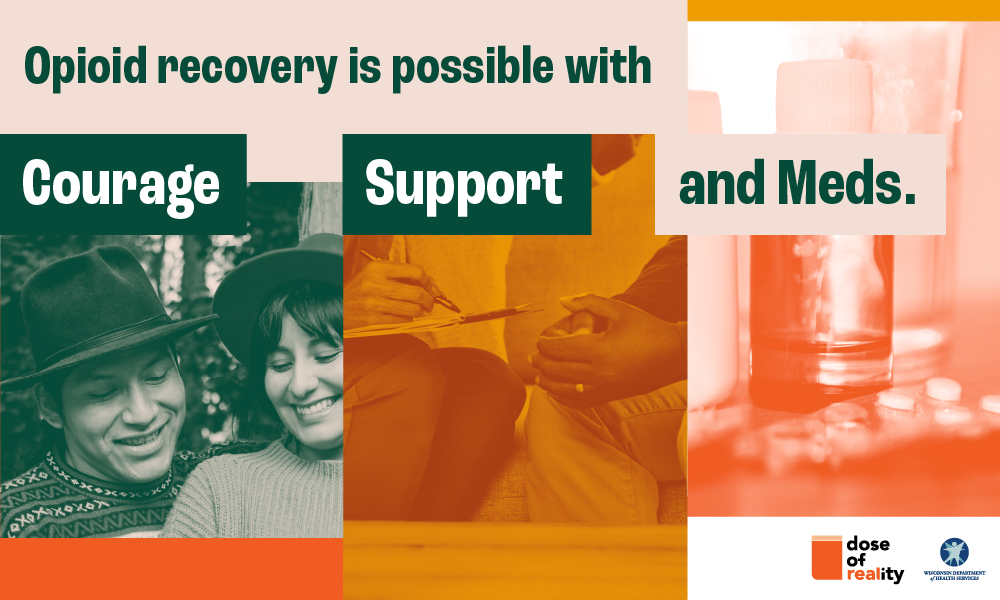
- Details
- By Wisconsin Department of Health and Human Services
Nationally, an estimated 2.5 million adults are living with an opioid use disorder, yet only 1 in 5 of them are getting the medications to treat it, according to a recent study from the National Institute for Drug Abuse. The researchers also found that some groups are substantially less likely to receive medication for opioid use disorder, including women, people of color, those who are unemployed, and those in small towns and rural areas.
Wisconsin health officials say their experience in the use of medications for opioid use disorder mirrors national trends. The life-saving treatment is underused, prompting the Department of Health Services to launch a new campaign to change the perceptions of medications for opioid use disorder and connect people to treatment.
“Stigma and misinformation surrounding medications for opioid use disorder may prevent people from seeking the help they need,” says Michelle Haese, the department’s director of substance use initiatives.
Haese says like other chronic illnesses such as asthma, diabetes, and hypertension, opioid use disorder is manageable through medication. Opioid use disorder is a persistent condition that involves continued use of opioids despite adverse effects on health and well-being. Effective treatment for opioid use disorder also includes therapy. The medications reduce cravings for opioids and the risk of overdose and death. Haese also says that therapy helps people change their attitudes and behaviors related to opioids and helps prevents return to use.
The medications for opioid use disorder include methadone, buprenorphine, and naltrexone. Many people who could benefit from taking these medications and associated therapy have not received this treatment because, Haese says, they may think willpower alone is enough.
“Opioid use disorder is a disease that often can’t be overcome solely through personal resolve,” Haese says. “Medications for opioid use disorder combined with therapy help to sustain recovery and prevent the personal and community harms caused by overdoses and overdose deaths."
The three medications for opioid use disorder have been recognized as safe and effective by the Food and Drug Administration. Methadone is available as a daily liquid. Patients take it at a certified opioid treatment program until they are cleared for at-home doses. Buprenorphine is available as a dissolving tablet, cheek film, or six-month implant under the skin. Health care professionals prescribe the at-home doses—the tablet or film—or administer the implant in an office setting. Naltrexone is available as a monthly injection. Any health care professional who prescribes medication can provide it.
There are 28 opioid treatment programs in Wisconsin that provide all the medications for opioid use disorder. More than 700 health care providers across the state are known to prescribe buprenorphine. Naltrexone is available at more than 100 locations in Wisconsin.
To support more people accessing medications for opioid use disorder, Haese says Wisconsin is enhancing resources through the "Get Help" section of DoseOfRealityWI.gov, the state’s website for information on ways to prevent and reduce opioid use. People also can get support from the Wisconsin Addiction Recovery Helpline by calling 211 or visiting AddictionHelpWI.org.
Medications for opioid use disorder are covered by most health insurance plans, including Medicaid. people unable to pay for medications for opioid use disorder should contact their Tribal nation or county health and human services department.
Following the release of the U.S. Department of the Interior's final report, we at Native News Online took a moment to reflect on our extensive three-year effort to highlight the traumatic legacy of Indian boarding schools. By covering all 12 Road to Healing events and publishing over 250 articles, we have amplified survivors' voices and illuminated the lasting impact on Indigenous communities. Our work continues. Please consider donating to help fund our ongoing coverage of Indian boarding schools.

